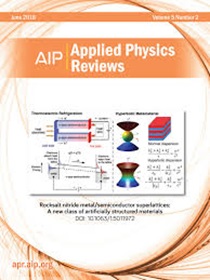Probing nanoscale structural perturbation in a WS2 monolayer via explainable artificial intelligence
IF 11.6
1区 物理与天体物理
Q1 PHYSICS, APPLIED
引用次数: 0
Abstract
This study investigates the applicability of the machine learning model in correlative spectroscopy to enhance spatial resolution for probing nanoscale structural perturbations. The developed model demonstrates significant enhancement in spatial resolution, achieving up to 50 nm through the integration of Kelvin probe force microscopy and atomic force microscopy data. The predicted nanoscale Raman image reveals abnormal behaviors associated with strain-induced lattice perturbations, such as the presence of compressive and tensile strains within identical nanoscale wrinkles. Afterward, we interpreted the trained model using explainable artificial intelligence techniques, uncovering synergistic contributions to the Raman features across each input dataset within the nanoscale region. Our analysis demonstrates that the model effectively reflects key strain-induced lattice behaviors, highlighting its nanoscale sensitivity to structural perturbations. Finally, we validated these findings using quantum mechanical calculations, which confirmed the strain-induced changes in Raman-active modes. This study offers comprehensive insights into nanoscale structural perturbations, paving the way for innovative approaches to high-resolution spectroscopic analysis in low-dimensional materials.通过可解释的人工智能探测WS2单层的纳米级结构扰动
本研究探讨了机器学习模型在相关光谱学中的适用性,以提高探测纳米级结构扰动的空间分辨率。通过整合开尔文探针力显微镜和原子力显微镜数据,所开发的模型显著提高了空间分辨率,最高可达 50 纳米。预测的纳米级拉曼图像显示了与应变引起的晶格扰动相关的异常行为,例如在相同的纳米级皱纹中存在压缩和拉伸应变。随后,我们使用可解释的人工智能技术解释了训练有素的模型,发现了纳米尺度区域内每个输入数据集对拉曼特征的协同贡献。我们的分析表明,该模型有效地反映了由应变引起的关键晶格行为,突出了其在纳米尺度上对结构扰动的敏感性。最后,我们利用量子力学计算验证了这些发现,证实了应变引起的拉曼活性模式的变化。这项研究提供了对纳米级结构扰动的全面见解,为在低维材料中进行高分辨率光谱分析的创新方法铺平了道路。
本文章由计算机程序翻译,如有差异,请以英文原文为准。
求助全文
约1分钟内获得全文
求助全文
来源期刊

Applied physics reviews
PHYSICS, APPLIED-
CiteScore
22.50
自引率
2.00%
发文量
113
审稿时长
2 months
期刊介绍:
Applied Physics Reviews (APR) is a journal featuring articles on critical topics in experimental or theoretical research in applied physics and applications of physics to other scientific and engineering branches. The publication includes two main types of articles:
Original Research: These articles report on high-quality, novel research studies that are of significant interest to the applied physics community.
Reviews: Review articles in APR can either be authoritative and comprehensive assessments of established areas of applied physics or short, timely reviews of recent advances in established fields or emerging areas of applied physics.
 求助内容:
求助内容: 应助结果提醒方式:
应助结果提醒方式:


